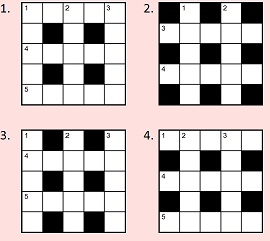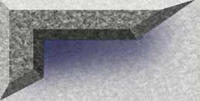One of the useful features of the Sympathy program (no longer available) is that it tells you if the grid you have designed has too many unches (consecutive or otherwise), and also if there are too few. You do come across grids where there is so much checking that some of the short words fill themselves in, and while this is not particularly desirable, it is obviously better to be too helpful rather than too unhelpful (something the staff of certain budget airlines have yet to learn).
You may well have noticed that there is another fault with my example grid. The four corners are separated from each other, so that essentially the grid contains four discrete mini-grids. This usually happens by accident, maybe as a result of blanking out white squares in order to fit in certain preferred words. Itís always a good idea to check that there is reasonable overlap between the four corners of any grid you design. As you can see, the grid here has large chunks of black running through it, and apart from being aesthetically unpleasing and wasting space, too many black squares joined together is quite a reliable sign that there may be something wrong with the grid.
There are four  basic grid patterns, as illustrated on the left. If you use Sympathy or Crossword Compiler to create your grids, all of these will be offered to you when you choose to design a grid from scratch. Pattern 1 is the one used for Times grids, and it has the advantage that you are unlikely to run into many problems with checking. It is also the most solver-friendly in that you have far more initial letters of answers checked, and getting the first letter towards an answer is very helpful.
basic grid patterns, as illustrated on the left. If you use Sympathy or Crossword Compiler to create your grids, all of these will be offered to you when you choose to design a grid from scratch. Pattern 1 is the one used for Times grids, and it has the advantage that you are unlikely to run into many problems with checking. It is also the most solver-friendly in that you have far more initial letters of answers checked, and getting the first letter towards an answer is very helpful.
Pattern 2 is more apt to lead to answers with too many unches, but can be useful if you want to include a Nina in your puzzle. Iíve also found from experience that Pattern 2 is more amenable to accommodating a large number of theme words. If there is a list of words that must appear in your grid, it can be awkward to fill in the rest of the grid without resorting to obscurities. It is easier to fit words together if there are fewer intersection points, as is the case with Pattern 2. Patterns 3 and 4 come somewhere in between in terms of advantages and disadvantages.
It has become standard practice that a crossword grid will have some degree of rotational or mirror symmetry. Thereís no reason why this should be apart from that it looks neater, but the convention has been established so firmly that if you submit a crossword with an unsymmetrical grid to any crossword editor, itís likely to be rejected right away. The only exception is in thematic puzzles like the Listener, where implementation of the theme may require an unsymmetrical grid. Be advised that even in this case there must be a very strong thematic justification for a lack of symmetry.
If all of this seems rather daunting, there is good news. You donít actually need to design a grid at all. Both Sympathy and Crossword Compiler provide a series of stock grids, and if you donít have either of these programs, you can use a blank grid from one of the newspapers. In the latter case you should populate the grid with your own words rather than use the original gridfill, in case there are issues of copyright. If you get on to the team of setters for a national newspaper, you will find that all of them (except the Independent) have their own sets of stock grids, so the matter of designing your own doesnít arise.
I always advise new setters to use ready-made grids if possible, so that they can concentrate on their clueing technique without having to worry if the grid is acceptable or not. If you want to ďseedĒ your grid with a few words for which you have already written clues, thereís absolutely no shame in using a stock grid with suitable answer lengths to accommodate these words. You may need to try your seed words in different positions in the grid, in order to avoid including obscurities or clue-unfriendly words among the remainder of the answers, and if necessary you can always modify a stock grid to suit your requirements. If you do make modifications, make sure that youíre not creating too many unches or, worse still, four unconnected mini-grids as discussed above.
I think I have covered all the things that can go wrong with grid construction, but I havenít included a detailed step-by-step guide to show the process of designing a grid from scratch. This is because I almost always use off-the-peg grids, which I then fill using my compiling software. For my FT puzzles I use the paperís stock grids, as required, and when I produce puzzles for the Independent or this site I use one of the many ready-made grids provided by the Sympathy program. I make changes to the stock grids if I canít otherwise fit in the words required for a theme, but it is very seldom that I construct the entire grid myself. Therefore I am probably not the best person to write such a guide, but fortunately there are a couple of superb articles which cover all aspects of designing a grid from scratch in detail. The first is on the excellent Crossword Unclued site, and the second is written by one of todayís leading setters, Anax.
As I said at the start, itís always a pity when a decently clued puzzle doesnít make the grade because of a substandard grid. I have written this piece in the hope that it will help to make the possibility of that happening less likely.

